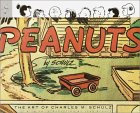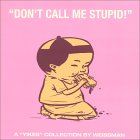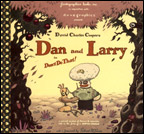 Having designed three superlatively handsome volumes detailing the histories
of DC Comics' most iconic characters (Superman, Batman, and Wonder Woman),
Chip Kidd now teams up with Art Spiegelman on Jack Cole and Plastic
Man. This book is not part of the same series as the aforementioned
triad, although it does hail from the same publisher (Chronicle Books)
and Kidd — at least for the interior — has followed a similar graphic template.
Having designed three superlatively handsome volumes detailing the histories
of DC Comics' most iconic characters (Superman, Batman, and Wonder Woman),
Chip Kidd now teams up with Art Spiegelman on Jack Cole and Plastic
Man. This book is not part of the same series as the aforementioned
triad, although it does hail from the same publisher (Chronicle Books)
and Kidd — at least for the interior — has followed a similar graphic template.
That said, Kidd subtly twists this template to make it contribute to
the narrative of the book even more organically that in his previous books.
Kidd surrounds Art Spiegelman's text (expanded from his New Yorker
article "Forms Stretched to Their Limits") with a dense and frenetic display
of his design virtuosity. The head-spinning and outrageous visuals of the
book are a perfect match for the pliable perversity of its subject: Jack
Cole's imagination.
Situating Jack Cole's Plastic Man in its proper place in comics
history — it is the too-often ignored missing link between Will Eisner's
The Spirit and Harvey Kurtzman's Mad — Spiegelman and Kidd treat
readers to a smorgasbord of information and art from this most important
stage of Cole's career, a career that also included being Playboy's
lead cartoonist and creating a successful syndicated comic strip, Betsy
and Me. Not that these, and other, aspects of his career are ignored
— far from it — but they are not allowed to overshadow Cole's most significant
contribution to culture: Plastic Man.
Ironically, in 1958, at the time of his suicide — as clearly stated
in a vintage newspaper clipping reporting on the cartoonist's death — Cole
was known primarily for the now completely forgotten Betsy and Me;
secondly, for his Playboy work, now mostly valued by collectors
of nostalgic memorabilia; and only thirdly for Plastic Man — the
work that is now considered not only one of the most sophisticated comics
of its day and but also an early example of a comics artist developing
a unique vision (especially from an era when comics were considered, more
than at any other time, disposable trash) and an essential stepping stone
in the development of the storytelling grammar of comics.
This section of the book — detailing Cole's suicide — is exemplary of
Kidd's skillful narrative use of design. Kidd uses art from a panoply of
Cole's works to create an impression of an out-of-control imagination being
straightjacketed to death. Meanwhile, Spiegelman explains that each successive
stage of Cole's career (from Plastic Man to Playboy to Betsy
and Me) — although outwardly signifying increasing commercial success
public recognition — actually boxed Cole into ever more restrictive mediums
that forced him to stifle his exuberantly perverse imagination. Whether
or not this contributed to his suicide, as Spiegelman implies, I have no
idea, but the case is well made that as Cole's star rose, his creativity
fell.
For me, there are only two false notes in Spiegelman's text. The first,
especially present in the early pages, is a whiff of snootiness as he feels
the need the justify, and not just celebrate, his love for Cole and Plastic
Man — a whiff that, to my mind, pays too much lip service to the general
cultural disdain for comics, emphasizing that it's okay to like Cole because
he is an exception and smugly raising both Spiegelman and Cole above "mere"
comic books. I have little patience or tolerance for such pretentious posturing.
The other is the overestimation of Cole's dramatic comics.
While Plastic Man — a zany pastiche of the superhero, detective,
and pulp science fiction genres oozing with polymorphous perversity — was
a great showcase for his talents, when applied to drama Cole's style degenerated
into hysterical melodrama and begged for the script to morph into a parody.
The reprint of the all-too serious and irritatingly maudlin "Murder, Morphine
and Me!" from True Crime Comics succeeds only in undermining Spiegelman's
praise for Cole's drama work and in proving that Cole's genius truly lay
elsewhere, in Plastic Man.
Perfectly rounding out this eye-catching labour of love is a bunch of
reprinted Plastic Man stories, and those truly show off Cole's timeless
artistry. Decades later, they're still great fun to read.
***
 Chip Kidd has carved out a niche for himself as the man for the job
for illustrated histories of comics. It is then no surprise to find him
as editor and designer of Pantheon Books' Peanuts: The Art of Charles
M. Schulz.
Chip Kidd has carved out a niche for himself as the man for the job
for illustrated histories of comics. It is then no surprise to find him
as editor and designer of Pantheon Books' Peanuts: The Art of Charles
M. Schulz.
An exquisite work of art in and of itself, Peanuts: The Art of Charles
M. Schulz functions as a kind of hand-held museum exhibit. It focuses
on the early years of Peanuts, but spans Schulz's entire career,
including glimpses at rarely seen pre-Peanuts work. Faithful to
Kidd's well-known passion for memorabilia, it also includes photographs
of Peanuts toys and merchandising.
It reproduces many Peanuts comics strips, featuring defining
moments for many of the characters and a few delirious fantasy scenes with
Snoopy. And the light text, which offers illuminating tidbits, never distracts
from the showpiece: the art of the most influential cartoonist of the twentieth
century.
***
 Charles Schulz's influence has reached beyond his chosen medium, the
comic strip. Steven Weissman's comic-book series Yikes is only one
of many such examples — not that Schulz's Peanuts is the only influence
informing Weissman's offbeat creation. Also thrown into the mix are Harvey
Comics (Richie Rich et al.), Bram Stoker's Dracula, Dennis
the Menace, The Family Circus, Chester Brown's Ed the Happy
Clown, Greek mythology, Pipi Longstocking, movie serials, pulp
magazines, horror movies, old comic-book ads, folktales, southern US fiction,
gothic literature, and ... well, you get the idea.
Charles Schulz's influence has reached beyond his chosen medium, the
comic strip. Steven Weissman's comic-book series Yikes is only one
of many such examples — not that Schulz's Peanuts is the only influence
informing Weissman's offbeat creation. Also thrown into the mix are Harvey
Comics (Richie Rich et al.), Bram Stoker's Dracula, Dennis
the Menace, The Family Circus, Chester Brown's Ed the Happy
Clown, Greek mythology, Pipi Longstocking, movie serials, pulp
magazines, horror movies, old comic-book ads, folktales, southern US fiction,
gothic literature, and ... well, you get the idea.
"Don't Call Me Stupid!" collects, in slightly different form,
most of the material from Weissman's three 1997-98 releases from Alternative
Press. Most of Weissman's work — including all of the material in this
collection — contributes to mapping the world of his series, Yikes.
Yikes is a strange, mythologized look at the world of children.
Yikes is not narrated as we have learned to organize the world as adults. Stories
begin and end in (seemingly) awkward places. Space and time don't follow
expected rules — and neither do life and death. What Weissman has achieved
is to create a childlike world of wonder, terror, and hijinks that utterly
refuses to conform to the consensus, adult interpretation of reality and
storytelling. In the world of Yikes, cruel violence is juxtaposed
with the games of childhood, and the mundane is more inexplicable than
the secrets of immortality.
Weissman's cast includes, among others, Li'l Bloody (a young, one-toothed
vampire), Dead Boy and Pullapart Boy (the reanimated "sons" of Professor
Boy), Kid Medusa (whose friends turn to stone if they look at her), X-Ray
Spence (the boy with the x-ray glasses), and the reanimated dog, Elzie
Crisler. In "Don't Call Me Stupid!" the Yikes kids square
off against the manipulative bully, Chubby Cheeks; try to learn the identity
of the serial killer behind the murder of a number of local children; smoke
cigarettes in the rain; and protect Li'l Bloody from his old enemy, the
"notoriously heavy sleeper" Rip Van Helsing.
Most notably, "Don't Call Me Stupid!" reprints Weissman's most
heart-wrenching tale, "Back in the Day ..." This 7-page gem features the
dog Elzie Crisler dreaming of the dreadful circumstances that lead to her
death, before being resurrected to a better life by Professor Boy. "Back
in the Day ..." evocatively contrasts brutality and tenderness while painting
with great empathy a picture of heartless disregard.
The stories in this Fantagraphics collection, like all Yikes
comics, are filled with the kinds of mysteries that actively involve readers
in the creative process. Weissman respects and exalts the intelligence
and imagination of children. Yikes is a children's comics series
that lacks even the slightest hint of condescension. "Don't Call Me
Stupid!" is an entertaining reading experience for those who have not
forgotten the alienating clash of childhood dreams with the dull conformity
of adult reality — and a beacon of hope for any still caught in that struggle.
***
 Dave Cooper's Dan and Larry in Don't Do That! is another Fantagraphics
comics album that deals with the clash between the worlds of childhood
and adulthood. Dubbed by the author "a surreal mixture of dreams &
memories," Dan and Larry is a much darker take on the whole thing
than Weissman's mischievous Yikes.
Dave Cooper's Dan and Larry in Don't Do That! is another Fantagraphics
comics album that deals with the clash between the worlds of childhood
and adulthood. Dubbed by the author "a surreal mixture of dreams &
memories," Dan and Larry is a much darker take on the whole thing
than Weissman's mischievous Yikes.
In Dan and Larry, Cooper once again tackles his trademark obsessions:
the violence, cruelty, and hatred that result from the repression and commercialized
distortions of sexuality. Here, he overlays these themes on a semi-autobiographical
tale of a twelve-year-old duck, Dan, who is troubled by his emerging sexuality
and by the incomprehensible sexualities of adult life.
In the world Cooper has imagined for Dan and Larry, anthropomorphic
animals, humans, cyborgs, and bizarre animals coexist. Disturbing technologies
evoking bodily functions permeate everyday life. Cooper's resonant use
of anatomical imagery emphasizes Dan's nightmarish plight.
Dan is best friends with the older Larry, a sexually confusing cyborg.
Dan inks Larry's self-published comics — describing the adventures of naked,
sword-wielding boys. Is Larry sexually abusing Dan? What is Larry's role
in Dan's sexual imagination? These are difficult questions. Cooper deals
with them in a surreal manner that intensifies their disturbing nature,
that leave readers to ponder the implications of Cooper's candid disclosures.
Dan and Larry is a harsh book that surrenders no easy answers,
a disturbing surreal journey into early adolescence. With Dan and Larry,
Cooper continues to build on his uncompromising body of work, an oeuvre
of fantastic surrealism that takes on sexual taboos with unabashed frankness
and daring ambiguity.




